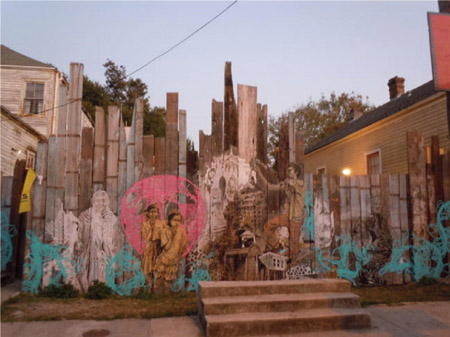
Researcher: Megan Guerber Region: Northern America
New Orleans, Louisiana is a city of music, art and blended cultures. When it was hit by Hurricane Katrina in 2005, lives and homes were destroyed throughout the city. While rebuilding efforts helped to fix up many blight- ed properties, years later the remains of Katrina’s destruction could still readily be found.
In 2008 the New Orleans Airlift initiative was founded to support artists struggling to re-establish themselves after Hurricane Katrina. Founded by artist manager and musician, Jay Pennington, and installation and multi-media artist, Delaney Martin, the program seeks to support the underground, living folk and street art cultures of New Orleans. Accord- ing to their website, by facilitating international travel for local projects as well as collaborations between local, national and foreign artists, New Orleans Airlift seeks to “empower learning and unite disparate groups in common and powerful goals.”
In 2011 Martin and Pennington purchased a property on which sat a collapsed 18th- century cottage. Situated in the Bywater section of the 9th Ward, the founders saw great potential for material reuse, life renewal and play within the property. Drawing inspiration from the music and potent creative energies of the New Orleans community, The Music Box: The Shantytown Sound Laboratory was born.
The project consisted of a temporary installation of “musical architec- ture” built using salvaged materials from the fallen cottage on their recently purchased property. Over 25 artists assisted in the creation of the musical structures and another 70+ musicians were invited to perform within the space during a performance series (October 22, 2011 - Decem- ber 10, 2012). While tickets were sold for the concerts due to limited space and the inclusion of some big names, the Music Box space was otherwise open to the public for exploration, play and interaction. In addition, free tours were conducted four times a week through the end of January 2012. During its temporary installation, over 15,000 visitors stopped by, including local residents, art lovers, tourists and 500+ students.
The whimsical musical buildings included “The Heartbeat House”, a shack-like structure with a speaker perched on its roof and attached at the other end to a stethoscope. By holding the stethoscope to their heats, visitors could project the rhythm of their own heartbeats. “Echo Wall” was constructed out of springs and steel sheeting and attached to a copper plumbing pipe. “Noise Floor” invited guests to create music with their feet and “Lookout Tower” combined a salvaged spiral staircase with pipes from a found church organ.
Plans continue for the site. Part of a larger project, The Music Box served as a trial run for Dithyrambalina, a permanent settlement of musical structures. In addition, New Orleans Airlift’s headquarters will be housed in a building designed by Brooklyn-based street artist Swoon who contributed wheat paste art to the previous settlement.
Currently The Music Box’s structures are living on as a “roving village” that will travel throughout New Orleans and the United States to share the playful inspiration of the Music Box and New Orleans art community.
Overall, The Music Box was a very successful project that brought a lot of hope to both the Bywater neighborhood and art community of New Orleans. By repurposing salvaged materials and recognizable pieces of architecture, important New Orleans culture and history was preserved in an era of lifeless, fast new property developments. In addition, the street, folk and underground art communities have been given new life and legitimacy within the project. The project also provided a space for innovation, hope and play, showing the local community that Hurricane Katrina did not take everything away and the larger community the potential of creative reuse. |